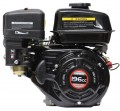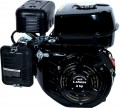Power
The rated power of the engine in horsepower (in fact,
the maximum power that the unit can produce in normal operation, without overloads). Despite the popularity of the designation in watts (see below), horsepower (hp) is still quite widely used to indicate the power of internal combustion engines. 1 HP is approximately 735 watts.
In general, the more powerful the engine, the more speed and tractive effort it is able to develop. On the other hand, this indicator directly affects the weight, dimensions, and most importantly, the cost of the unit, while the real need for high power is relatively rare. Therefore, it is worth choosing according to this indicator, taking into account the features of the planned application; specific recommendations on the selection of an engine for a specific technique and tasks can be found in special sources. We only note that models of the same power can differ in speed and "torque"; see "Shaft speed" for details.
In general, performance up to 8 hp. are considered low, up to 13 hp. — medium, more than 13 hp — high.
Power
The rated power of the engine (the highest power it can deliver in normal operation) in kilowatts. Initially, the power of internal combustion engines (ICE) was usually denoted in horsepower, but now it is also common to record in watts / kilowatts; this, in particular, makes it easier to compare the power of internal combustion engines and electric motors. Some units can be converted to others: 1 hp approximately equal to 0.735 kW.
In general, the more powerful the engine, the more speed and tractive effort it is able to develop. On the other hand, this indicator directly affects the weight, dimensions, and most importantly, the cost of the unit, while the real need for high power is relatively rare. Therefore, it is worth choosing according to this indicator, taking into account the features of the planned application; specific recommendations on choosing an engine for a specific technique and tasks can be found in special sources. We only note that models of the same power can differ in speed and "torque"; see "Shaft speed" for details.
Max. torque
The maximum torque developed by the engine during operation. Note that such an indicator is usually achieved only at certain speeds — this nuance can be specified in the characteristics.
Torque can be simplistically described as the force exerted by a motor on a shaft. The higher this effort, the more “high-torque” the motor is, the better it overcomes resistance and handles with high loads. The torque value is directly related to the power. For example, for 5 hp models. and less torque
up to 10 Nm is considered quite normal, engines of 4 – 7 hp. give out
from 10 to 20 Nm, and values
of 20 Nm or more are found in units with a power of at least 8 hp. At the same time, engines of the same power may differ in actual force. So this indicator characterizes the capabilities of the unit well in comparison with analogues.
It is worth saying that many consider torque to be a more reliable and visual parameter than power: the latter can be indicated in different ways (nominal, maximum, etc.), while torque is a completely unambiguous characteristic.
Shaft type
Shaft type, more precisely, the type of fastening for the hub provided on the shaft shank.
Recall that a hub is a part with a hole that is put on the shaft; it is through this part that the rotation is transmitted to the mechanism with which the engine is used. The general rule in this case is this: the type of shaft must match the type of mounting on the hub, otherwise normal operation will not be possible. Nowadays, there are units with shafts
under the key,
under the spline,
under the cone and
under the thread. Here is a more detailed description of each option:
— Dowel. Connection using a key — an elongated part placed in a special longitudinal groove. More precisely, there are two grooves: one is located on the shaft, the other is on the hub, and the key is tightly installed in the space formed by the grooves and connects the shaft and the hub. Such connections are simple and at the same time quite functional, due to which they are widespread and found in engines of all price and “weight” categories. On the other hand, a keyed connection is less secure than a splined connection and is less suitable for high RPM and/or heavy loads.
— Slots. Connection based on slots — longitudinal slots. Most often, there are six of them on the shaft, and the seat on the hub has the appropriate shape — in the form of a charac
...teristic asterisk. A spline connection is more complicated and more expensive than a keyed connection, and numerous slots reduces the strength of the shaft and it has to be made thicker. However, the connection itself is very reliable, as it evenly distributes the load during rotation. Therefore, splines are recommended for work at high loads.
— Cone. A shaft with a shank in the form of a cone (tapering towards the end), in the centre of which there is a hole with an internal thread. It is used quite rarely, mainly on fairly powerful units — from 7 hp. and higher.
— Carving. Cylindrical shank with external thread. A rather specific option that has not received much distribution — in particular, due to the fact that the thread tends to loosen from vibrations as it is used, and significant efforts may be required to connect and disconnect the shank and hub.Shaft rotation
Direction of rotation of the motor shaft. Usually, it is indicated by the direction in which the shaft rotates, if you look at it from the flywheel side (from the side of the engine from which the power is taken off). The classic option is counterclockwise rotation, but the opposite direction is also found. Anyway, the main selection criterion for this parameter is what direction the car is designed for, under which the engine is bought.
Shaft speed
The highest shaft speed provided by the motor. Before buying, you should make sure that this indicator corresponds to the characteristics of the equipment in which you plan to install the engine — too high a speed can damage the working tool, transmission units, etc.
It is also worth considering that a higher rotational speed (for the same engine power and transmission characteristics) means less torque, and vice versa. Therefore, this parameter allows you to compare engines in terms of the speed / thrust ratio (however, only on the condition that they do not have reduction gears — see "Functions").
Shaft diameter
The diameter of the motor shaft, more precisely, the diameter of its outer part, located behind the housing. Data on the diameter of the shaft is needed to clarify the compatibility of the engine with the mechanism for which it is bought.
Now on the market there are shafts with the following diameters:
16 mm,
19 mm,
20 mm,
22 mm,
25 mm.
Capacity
The working volume of all engine cylinders. Usually, other things being equal, a larger volume allows you to achieve higher power, but increases fuel consumption and affects the dimensions of the unit.
Compression ratio
The compression ratio provided by the engine.
The compression ratio is the ratio of the total volume of each cylinder (above-piston space at the extreme lower position of the piston) to the volume of the combustion chamber (above-piston space at the extreme upper position of the piston). Simply put, this parameter describes how many times the over-piston space decreases when the piston moves from the bottom to the top.
A higher compression ratio, on the one hand, contributes to an increase in engine efficiency and allows you to achieve more power (compared to analogues of the same volume) and lower fuel consumption (compared to analogues of the same power). On the other hand, with an increase in the compression ratio, the likelihood of detonation (“knocking in the engine”) also increases, which puts forward increased demands on the quality of the fuel.
The lowest compression ratio found in modern engines is about 5.6:1, the highest is about 19:1.

